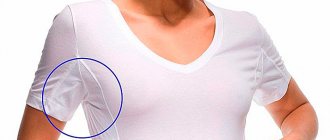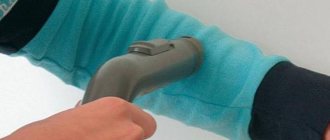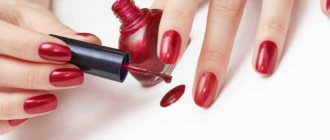Causes of yellow sweat
Normally, human sweat is transparent and colorless. If it suddenly acquires a tint of color, it means that not everything is in order in the body.
Thus, yellow sweat under the arms and in other places is caused by the production of the pigment substance lipofuchsin, which affects the functions of the sweat glands. Causes of abnormal coloration may include:
- Genetic predisposition, when one of the blood relatives suffers from a similar problem.
- Neglect of personal hygiene rules. Prolonged and repeated exposure of clothing to sweat leads to the appearance of not only stains, but also salt crystals. All this contributes to the rapid growth of pathogenic flora, the formation of an unpleasant odor and the appearance of foci of inflammation on the skin.
- Staying in stressful situations for a long time, when yellow sweat appears from excitement and stains clothes in the areas of excretion.
- Chronic pathologies in the acute stage.
- Unfavorable ecology when there is a high concentration of harmful substances in the soil, water and air.
- Work in “harmful” industries.
Sometimes the sweat secretion has a distinct smell of urine. This means that the filtering function of the kidneys is impaired and there is reason to immediately consult a doctor.
Often, bright, yellow sweat bothers teenagers. During puberty, hormonal changes in the body occur, which may be accompanied, among other things, by abnormally high sweating. Moreover, the secretion has not only color, but also a pungent odor. This situation should not be considered a pathology, because with the completion of puberty the problem goes away.
To solve the issue and eliminate discomfort, proper hygiene and the use of special cosmetics that reduce the amount of sweat secretion and eliminate unpleasant odors are sufficient.
It was mentioned above that lemon-colored sweat can be provoked by reasons related to health problems. One of these is Gilbert's syndrome, a condition in which the blood contains too much indirect bilirubin. It is also called pigmentary hepatosis.
Skin tone in Gilbert's syndrome.
People with this pathology suffer:
- yellowing of the skin and white area of the eyes;
- increased sweating that occurs day and night. The sweat has an ocher tint and a repulsive odor.
This is how the skin color of a person with jaundice differs.
Other symptoms resemble those of jaundice:
- pain appears in the liver area;
- the overall tone of the body decreases;
- high fatigue is noticed;
- sleep is disturbed. This makes a person look tired and irritable during the day;
- heart rate increases;
- chills bother me.
Such a detailed description should give rise to thought for those who, in addition to yellow sweat, suddenly discover symptoms of pigmentary hepatosis. It is important to understand that the condition requires serious medical correction, and therefore you should not delay your visit to the doctor.
Moreover, the cause of the development of Gilbert's syndrome can be such trivial circumstances as:
- taking a number of medications;
- destructive passion for alcoholic beverages;
- the predominance of a large amount of heavy food in the diet - fatty and fried;
- liver dysfunction.
Proper therapy will help get rid of unpleasant symptoms, including the problem of yellow sweat.
Folk wisdom, or how our grandmothers fought sweat stains
The problem of sweating is an old one. When soap had not yet been invented, and there was no trace of powders, people resorted to various means to make their clothes snow-white again. What was going on?
- Baking soda, regular soda. Let's start with the fact that this product is an alkali, which actively reacts chemically with salt. Namely, the salts remain when the sweat moisture evaporates. That's why soda so actively cleanses things from dirt. The housewife needs to prepare a solution: 4 tablespoons per quarter glass of warm water, rub it into the damaged fabric and leave for a couple of hours, and then wash. The mark, if it does not disappear completely, will be less noticeable.
- Vodka. If there is no alcohol, vinegar will do. They need to be mixed again with water in a one to one ratio and applied to the damaged area of the fabric. Only in this case it is not recommended to rub in, it is better to lightly sprinkle. Leave for about an hour and wash as usual.
- Salt. It’s also a good remedy, but it doesn’t give such a noticeable result as the first two. Prepare an aqueous solution in the proportion of 1 cup per liter of liquid, apply to the stain, leave to sit for two hours, and wash. The method helps, but you shouldn’t expect amazing results from it.
Chromohidrosis - what does it mean?
A variety of shades of sweat with chromohidrosis.
Human sweat can take on more than just yellow hues. It happens:
- blue;
- green;
- red;
- and even black.
This phenomenon in medicine is called chromohidrosis and develops, most often, against the background of existing problems with sweating, for example, with hyperhidrosis.
The reasons are similar to those mentioned when describing the problem of yellow sweat:
- influence of harmful chemical compounds from the external environment;
- insufficient body hygiene.
Chromohidrosis is classified into:
- false (pseudochromohidrosis);
- true.
To understand how they differ, it is worth taking a closer look at each variety.
Pseudochromohidrosis
It is characterized by the release of normal sweat secretion, which becomes colored while on the skin. Workers in hazardous industries often suffer from this problem. Sweat staining does not occur on the entire body, but locally. The color of the discharge depends on the chemicals a person is dealing with:
- the blue tint comes from methylene blue, which is used to dye fabrics in the textile industry;
- green – due to the influence of copper and brass;
- red comes from working with potassium permanganate. It is often used as an oxidizing agent in chemical industries.
Bacteria and fungi that live in the area of increased sweating in people with hyperhidrosis can change the color of sweat. They can give sweaty skin ochre-brown, reddish and even black hues.
Sometimes the color of sweat secretion simply takes on the color of clothing dyes.
True chromohidrosis
The phenomenon is quite rare, characterized by abnormalities in the structure of the sweat glands and hereditary predisposition. With this type of pathology, sweat initially has a yellow color, but under the influence of various factors it acquires the same range of shades that the false form gives.
Features of removing stains from white, black and colored items
When cleaning, you should take into account the color of the material, since not all products are equally suitable for white, black and colored clothes. Ignoring the rules of procedure causes deformation of the fibers after processing.
Removing stains from white laundry
On white items, traces of antiperspirant are especially noticeable.
The following cleaning agents solve the problem:
- White spirit combined with ammonia . Mix in equal quantities. Dampen the sponge, then rub the dirty cloth. Wait 10 minutes.
- Soda . Dissolve 2 tablespoons of the component in 150 ml of cold liquid. Distribute the solution onto the fabric and leave for 30 minutes.
Eliminating stains on dark clothes
To clean dark material, you should use products that will not spoil the shade.
Therefore, these cleaning components are suitable:
- Vodka . Apply, wait 30 minutes. If traces remain, extend the waiting period to 40 minutes.
- Laundry soap. Rub a piece of soap and add a little warm liquid. Stir until a soapy slurry forms. Distribute it and wait 90 minutes.
Removing stains from colored clothing
You can clean colored fabric from traces of antiperspirant using the following cleaning components:
- Acetylsalicylic acid . Grind 3 tablets to a powder consistency. Sprinkle the mixture onto the contaminated area, rubbing into the fabric. Lightly wet and rub with a brush. Leave it like this for 3 hours.
- Salt solution . Add a little warm liquid to make a paste. Distribute the mixture on the back of the fabric, lightly rubbing into the fibers. Leave for 15 minutes. Wash with laundry soap and rub.
Diagnosis of pathology
Many people are afraid of colored stains from sweat on clothes and bodies. People go to the doctor, and this is the right decision. Especially when you consider the range of possible causes of abnormal sweat.
To understand each specific case, diagnostic measures are carried out, which include:
- examination and collection of anamnesis (information about all diseases of the body identified at the moment);
- microflora testing (to identify pathogenic organisms);
- lumen diagnostics of problem areas of the skin;
- blood and urine tests.
If during the examination there are grounds to suspect the presence of new pathologies, additional research and consultation with more specialized specialists are possible.
A few tips and warnings
To effectively get rid of stains caused by sweating, without damaging the fabric, you should remember a few simple rules:
- Bleach should not contain chlorine. This chemical reacts with proteins in sweat, causing the fabric to darken. Such contaminants are extremely difficult to remove.
- Violent rubbing of fabric coated with stain remover will cause color loss and compromise integrity.
- Acetic acid cannot be used for silk acetate products.
Treatment methods
Treatment methods for chromohidrosis largely depend on the causes of its occurrence:
- When the release of colored sweat is associated with health problems, the emphasis is on eliminating the main pathology, and then, if necessary, auxiliary methods are followed.
- If the cause of the condition is exposure to harmful industrial or environmental factors, there is reason to think about changing your job or place of residence.
In some cases, to eliminate hyperhidrosis, and at the same time the problem of colored sweat, doctors offer radical methods:
- ultrasonic destruction of sweat glands;
- removing them by liposuction or endoscopic curettage;
- surgical excision of an area of excessive sweating, removal of a fragment of skin with sweat glands located on it.
Radical methods can cause complications such as compensatory hyperhidrosis, that is, the formation of new areas of excess sweating. In such cases, a course of acupuncture is indicated.
Recently, Botox injections have been used as a new method in the fight against hyperhidrosis. They are guaranteed to relieve the problem of excessive sweating, although not for long. Eight to ten months later the procedure will have to be repeated.
Prevention of chromohidrosis
To prevent chromohidrosis, it is recommended:
- bring the drinking regime back to normal;
- Follow the rules of personal hygiene, using soap or other non-aggressive shower products. It is important not to forget to change your underwear and bed linen in a timely manner;
- avoid the influence of stressful situations and cultivate stress resistance;
- use clothes according to the season and weather, suitable size, comfortable cut, made from natural, hygroscopic fabrics;
- balance your diet so that natural fruits and vegetables, as well as dairy products, predominate;
- when working in hazardous industries, use special clothing, shoes and personal protective equipment;
- spend more time in the fresh air;
- take care of strengthening the immune system;
- promptly and completely eliminate health problems.
Thus, excessive body hydration, and therefore the risk of colored sweat, can be prevented and eliminated. To do this, it is important to lead a healthy lifestyle, monitor your condition and not be afraid to visit a doctor.
Fighting old pollution
Unfortunately, it is not always possible to promptly apply one of the above methods for removing stains from sweating. The item dries out, which strongly binds sweat into the fibers of the fabric.
You can wash a blouse, shirt or sweater if you first soak the item in water with bleach or powder. After this, begin to use one of the following methods for getting rid of stains “with a history.”
Aspirin + hydrogen peroxide
A mixture of a teaspoon of water and two crushed aspirin tablets is applied to the previously soaked item, after which it is returned to water with bleach for 3 hours. After this time, the clothes are lightly washed. Separately mix water with hydrogen peroxide (proportion 10:1). The resulting solution wets the stains. Another 10 minutes and the clothes can be washed. A labor-intensive but reliable way to get rid of stains.
Soda with vinegar
Removing stains using this method is not as difficult as in the previous version, but no less effective. The first stage is preparing vinegar water for soaking. 2 tbsp. l. vinegar are diluted in five liters of water. Before soaking, the stains are rubbed with a paste of soda (4 tablespoons) and water (1 glass). The item is left for one hour, after which it is washed in the usual way.











